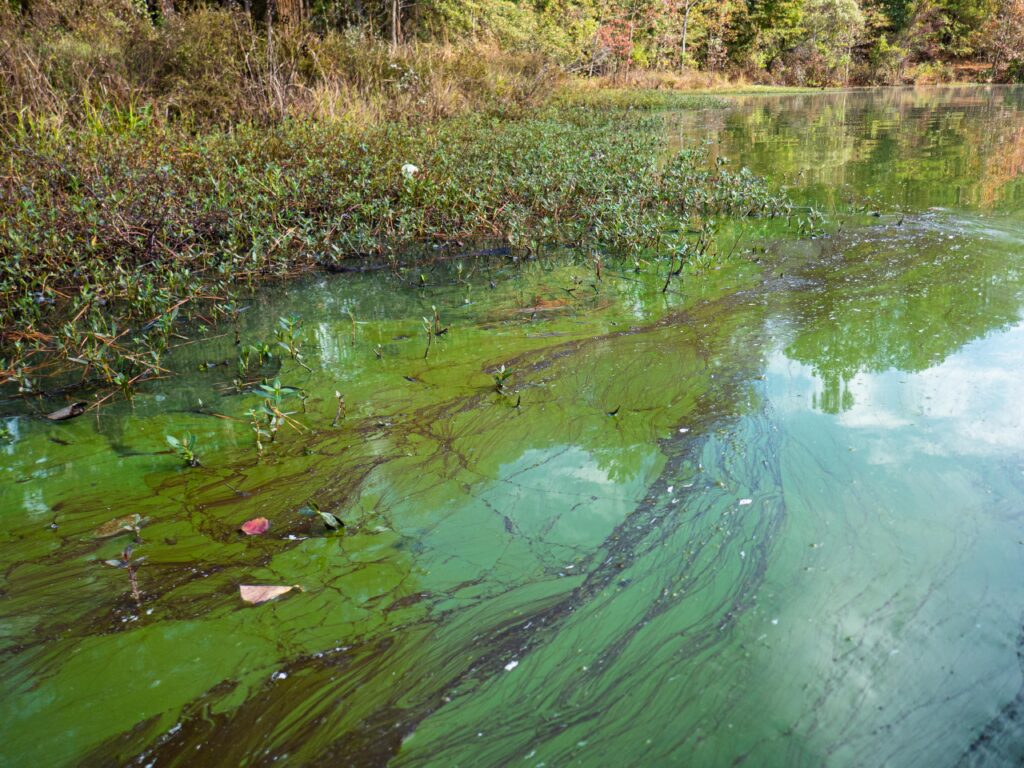
Harmful algal blooms, or HABs, occur when certain species of photosynthetic bacteria called cyanobacteria overgrow and produce toxins that can impact people, fish, birds, and other wildlife.
Scientists predict that climate change and increasing nutrient pollution may cause HABs to occur in many locations not previously affected. Chattahoochee Riverkeeper is working to identify HABs in the Chattahoochee River, its lakes, and tributaries. Learn more below.
FAQs
What are harmful algal blooms?
Harmful algal blooms, or HABs, are created when high amounts of naturally occurring cyanobacteria (also called blue-green algae) grow out of control and produce cyanotoxins that can be harmful to animal and human health. Cyanotoxins can cause human and animal illness through skin contact, ingestion, or inhalation. Different species of cyanobacteria produce different toxins that impact the nervous system, liver, skin, or stomach.
Why do harmful algal blooms occur?
Cyanobacteria occur in freshwater and saltwater environments all over the world, but become problematic when they overgrow and produce toxins called “cyanotoxins”. Scientists predict that climate change may cause HABs to occur more frequently over time. Increased rainfall can deliver excess nutrients to waterways, feeding the cyanobacteria and causing blooms. Also, warmer, slower-moving water can promote the growth of cyanobacteria. Most conditions along the Chattahoochee River (cold water, fast current) prevent HABs from becoming a problem locally. However, in stagnant or still water on lakes and reservoirs it is possible for cyanobacteria to bloom to problematic levels.
Where are harmful algal blooms in the Chattahoochee?
In 2021, we documented the first suspected animal death due to a HAB on the main stem of the Chattahoochee River in Bull Sluice Lake along the Gold Branch Trail near trail marker GB-7. In addition, we have confirmed reports of HABs on Lake Harding in the Middle Chattahoochee region in July and August 2021.
What do harmful algal blooms look like?
The cyanobacteria that cause HABs may produce a visible, smelly green scum or may be attached to sediments on the bottom of a river or reservoir. The clumps of cyanobacteria can be very hard to identify as problematic or not. The presence of cyanotoxins can only be confirmed with laboratory tests. We are working in partnership with Chattahoochee River National Recreation Area, University of Georgia, and Auburn University to conduct laboratory testing to confirm suspected HABs.
What can I do to protect myself and my pets against harmful algal blooms?
Consuming these toxins can lead to illness. If you see suspicious green discoloration in the water, avoid contacting the water and keep pets away because these blooms can make you sick through skin contact, ingestion, or inhalation. In general, CRK recommends that pet owners always exercise caution when exploring natural waterways and avoid stagnant or greenish pools of water and be sure to bring drinking water for pets.
What should I do if I suspect harmful algal blooms are in a waterway?
Visual signs of a bloom include surface water discoloration (for example, a bright green, blue, brown, or red tint), a pea soup or spilled green/blue paint-like appearance, reduced transparency, thick mat-like accumulation of scum, and/or dead fish. If you see visual signs of a bloom or suspect pollutants or environmental issues in a waterway, please contact CRK via our hotline below or by calling (404) 352-9828. Reports should also be made to the proper state authorities. For Alabama complaints, please report to the Alabama Department of Environmental Management. For Georgia complaints, please report to Georgia Environmental Protection Division by emailing askEPD@gaepd.org.
Report suspected HABs
Report A Problem
"*" indicates required fields
More Updates
Follow CRK on social media to keep up with our work and additional updates regarding harmful algal blooms in the Chattahoochee watershed.
